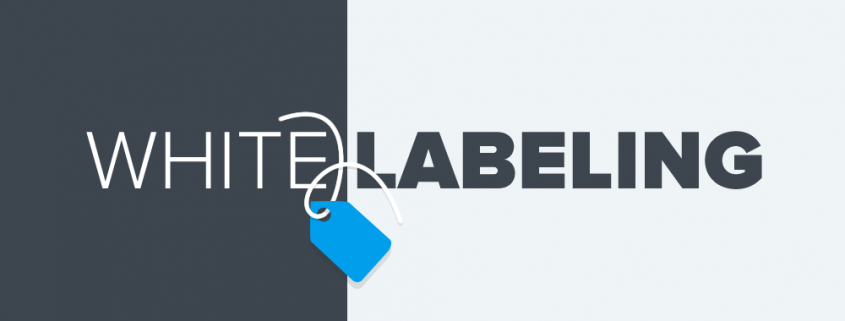How To Use White Labeling To Bring in an Extra 6 Figures Next Year
Agency owners often find themselves in a tricky situation as they try to grow. Typically, they start out with limited services, oftentimes just one or two. But as they look to grow, they want to do more. More to help their clients, more to bring in revenue, sometimes just more for more’s sake.
So they look to branch out. Say they started by selling only SEO services, so they decide they also want to offer PPC services to their clients; or they started selling only websites and decide to branch out to video marketing. It’s a natural – and good – impulse to have as a business owner.
However, as they start to figure out what it looks like, they run into a ton of problems, particularly on the financial side of things. If they want to hire someone in-house, they need enough of a workload to justify hiring an expert who can uphold their expectations for quality work. While agencies might have saved enough to justify some time for growth into a new service, it’s still a risky proposition.
There’s also the problem of developing a new department within the agency, for which there needs to be defined processes, clear KPIs and ongoing performance oversight. That can take a lot of work, and if the agency owner isn’t very familiar with the new service, it can be a steep learning curve to understand the nuts and bolts of how the service works as a functioning part of their agency.
In short, it sounds easy, it sounds like a no-brainer. But it’s far from that. At the same time, agencies that choose to focus on just one service do limit themselves, and often find it difficult to find enough clients to justify their singular focus.
But what if I told you there was a solution for both of these problems? One that minimizes risk, provides clear profit margins and requires minimal oversight on the part of the agency, whether they’re looking to increase their volume for a singular service or want to offer more services to their clients.
What’s the name of this golden egg? White labeling.
Why I Believe in White Labeling
For clarity, throughout this post I’ll refer to the company hiring the white labeler as the “agency” and the company white labeling their services as the “service provider,” regardless of if they’re a freelancer or agency. This distinction is important because white labeling is a mutually beneficial arrangement for both agencies who hire white label services and for service providers who want to white label their services to an agency.
As an agency that wants to sell more services to clients but can’t afford to hire a full team or pay six-figure salaries, a white label solution could help you by allowing you to focus on sales, minimize overhead and generate more results for your clients. On the other hand, if you are service provider that wants to grow their client base and have a consistent stream of new clients but doesn’t have time to do sales, or simply has no interest in it, white labeling can help grow your revenue by focusing on fulfillment.
In a nutshell, white labeling allows two companies to form a mutual relationship that, if executed correctly, can allow both parties to add five, six, or even seven figures to their yearly revenue. I’ll start by outlining the strategy for the agency, and follow that up with one for the service provider. Regardless of which camp you’re in, it’s important to read this entire guide to have a full understanding.
What You’ll Learn
- What exactly is white labeling – we’ll take an in-depth look at what white labeling is from the perspectives of both an agency and a service provider.
- How to grow your agency using white labeling – here you’ll learn how using a white-labeled service can massively increase your bottom line and take your business to the next level.
- How to grow your business by white labeling your services – as a service provider who wants to stay focused on one service and isn’t interested in sales or marketing, here’s how you can use white labeling as a highly scalable model for growth.
- How to find the right partner, and how to work together – sometimes the trickiest part is finding the right partners to work with. Here we’ll help you pay attention to the right things and make sure you’re properly evaluating potential partners.
What Exactly is White Labeling?
There are two main ways that you can approach white labeling: White Labeling and Open White Labeling. Let’s start with white labeling.
The Benefits of White Labeling
White labeling is simply taking someone else’s work and slapping your logo on it. If you’ve ever been to a chain supermarket you’ve certainly seen the supermarket brand products sitting next to the name brands. In many cases, that’s the same product as the branded product, just with the supermarket’s name on it. That’s a popular form of white labeling.
Your business likely already has some form of white labeling through the tools or software you use. For example, if you use a rank tracking tool, you’ll often have the ability to export a rankings report while uploading your logo to appear on the report.
The advantage with white labeling is, of course, you get the credit. Your agency looks great! You’re offering more great services than the other guy without the need to hire additional employees or pay for your own tools.
For instance, if you’re white labeling SEO services (which is the service I’ll use for most of the examples as 80% of my experience with white labeling has been for SEO services), putting your logo on the proposals and reports and handing it off to your client, that grows your relationship with the client.
The client believes you’re doing the work generating the results and it might be easier to upsell them on other services – which, beyond the additional revenue, can also increase your retention rate.
Some businesses like to work with just one marketing provider, or at least have their channels and services consolidated as much as possible to limit their points of contact – meaning that being able to fulfill as many of their needs as possible improves your chance of keeping them on board.
The Drawbacks of White Labeling
Like most things, white labeling has its potential downsides. For instance, If the service provider messes up, in the eyes of your client you have just messed up. It’s nice to take the credit when things are going well, but it’s never fun to take the blame.
Say you hire an SEO service provider to white label for you and then they disappear or take down a client’s website or just do something generally shady. The client doesn’t know that they are even in the picture, so it’s directly reflected onto you.
You as the agency took down their website. You as the agency failed to get them results.
Ouch.
The Benefits Open White Labeling
Open white label is at its essence the same, but the end consumer or client is made aware that someone else is providing the service. This is an open partnership.
An example would be if I partner with a local web designer and he tells his clients that he teamed up with a marketing expert to provide search optimization services because that’s not something that his company does but still wants to provide. It’s transparent and the client is aware that the SEO is being white labeled.
The main advantage of taking an open white label approach is that there’s no worry about the client finding out that someone else is doing the work that you, the agency, were hired to do. It’s rarely nefarious in any way, but it can look bad if it comes as a surprise. Plus, if the service provider messes up, then it’s not as much on you, though you should still expect to take some of the blame, as you should.
The Drawbacks of Open White Labeling
This, too, comes with its own cons, though. There’s a lot more red tape. Questions can come up, like what if the client decides, for whatever reason, that they want to stop working with you, the agency, but continue working with the service provider?
In situations like these, a contract is needed, and it can be difficult to come to an agreement. But even with a contract, things can get weird in an open white labeling setup.
If your agency ends up outgrowing a client, or if you decide to let a client go for whatever reason, but the service provider is not interested in ending their work with the client, you may find yourself in a tight situation.
Problems with working for your clients’ competition can also arise. Say I do SEO for a roofing company in Dallas and I am also open white labeling my services to a company that provides SEO services for another roofing company in Dallas – well, you see the issue.
Well, this just got complicated…
No matter which route you go, there is always the risk of outgrowing your service provider. If you partner with a freelancer, their capacity may only be a handful of clients. Ultimately, it’s up to the service provider to decide if they want to scale based on the influx of work you’re able to supply.
It may just be too risky in case your partnership ceases and the service provider has a lot more salaries to pay than projects to afford it. And what if your service provider does just up and vanish?
While there are lots of possible problems that can arise in the midst of a white labeling partnership, most of them can be avoided by just taking intentional steps to outline what’s expected of the agency and service provider, how things could change with growth, and what the partnership’s limitations are.
The Key to Good White Labeling Partnerships – Trust & Clarity
The point being – if you, as either the agency or the service provider, want a relationship to work, then it’s pivotal to consider each other as partners. It needs to be a relationship built on trust, transparency and honesty.
One of the most common mistakes that agencies make is treating the service provider like a vendor or an employee, believing that they have all the leverage and are in complete control of the agreement because they’re paying the invoice.
In my experience, it’s very much the other way around. The service provider has a lot more leverage than the agency in that situation.
The agency is hiring the service provider based on their specific skills and expertise. Just check out any marketing Facebook group, there’s a dozen people making money by selling a marketing service that they themselves can’t provide, but there are very few marketers who are actually able to deliver a quality service that generates a return on investment (ROI).
This doesn’t mean that the service provider gets to act all “high and mighty,” though. In any partnership, there is going to be give and take on both sides. Both parties may have to work outside their norms, from processes to delivery and payment.
Both parties need to go into the relationship imagining if their two companies were merging into one, and how that would play out. It really needs to be that symbiotic. Otherwise things can become unclear quickly and tension can build fast.
That sounds like a lot more work than it really is. Really, it’s mostly about expectations. In fact, most of my agency partners work an hour a month on the projects we fulfill, and they’re not involved in strategy (unless needed) – we just understand how each of us needs to behave in our relationship, which we determined upfront.
How To Grow Your Agency Using White Labeling
Most agencies feel as though they will be making a lot more money by hiring in-house, but frankly, that’s just not true. And besides saving money, white labeling also allows you to save time and resources.
If you white label, you don’t have to a hire and train an entire team. If you were to build out an entire SEO department, you’d be looking to hire a project manager, account manager, Sr. SEOs, SEO specialists and SEO VAs or Jr. SEOs.
Plus, just hiring a Sr. SEO is expensive in itself. Senior level people can easily cost six figures a year. Don’t just take my word for it:
- SEO Director: $57,788 – $149,578
- SEO Manager: $41,913 – $94,655
- SEO Specialist: $29,448 – $63,744
- Total Salaries: $129,149 – $307,977
And that’s just for three people! You’re gonna need a lot more than that!
Even if you just have two SEO specialists, that’s still $58,896 – $127,488 a year, with an 80 hour a week cap. Depending on the clients you work with, that could be 5-20 total projects before they’re stretched thin. How profitable would you be?
On top of not having to hire a team, there’s no extra overhead to worry about. You’re not going to have to have your own ranking tools, subscriptions to Ahrefs, Majestic, SEMRush, Screaming Frog, or the dozens of other tools that most SEOs have that can easily add up to $500-$1500+ a month.
Plus, assuming you are the founder and/or CEO of a small agency, you’re probably still doing some level of fulfillment yourself, which means white labeling can save you time and make you a lot more money.
Let’s do some quick math comparing the profitability of SEO by hiring an in-house person or having a white label partner:
Note that the math will not be perfect for every situation and the numbers are based on additional income. That is, this does not factor in your other employees’ salaries, your salary, or your business revenue as apart from the service (SEO) we’re comparing.
The CEO salary may seem quite small when we get to the white label section, but that’s the potential additional salary. $20,000 means an extra $20,000 to your current salary.
Let’s say you hire one in-house SEO specialist.
- Hours a week spent on projects: 35
- Yearly salary: $30,000
- Clients they can handle at a time: 5
- Monthly cost of your SEO tools: $500
- Annual: $6,000
- Hours spent managing in-house person: 10 a month
- Hourly worth: $100
- Salary drawn from work: $1,000 a month
- Average client budget: $2,000 a month
- Profit margin (without salaries): 80%
- Yearly income from 5 clients: $96,000
- Client income – (employee salary + cost of tools + CEO Salary) = $48,000 business profit
This does not factor in what happens when you gain your sixth or seventh client and have to hire, train and manage another SEO specialist, and then hire someone to manage both of them.
Math is hard. Take a break with this cat!
What about working with a white label partner?
- Average client budget: $2,000 a month
- Retained per client: $500 a month + $1,000 setup fee
- Clients: 5
- Yearly net profit on 5 clients: $35,000
- Hours a month you spend on projects: 3
- Hourly worth: $100
- Salary drawn from work: $300 a month
- Extra salary: 100% of all set up fees
- Month’s salary: $5,300
- (you can pay yourself whatever, this is showing if you pay yourself hourly + the setup fee)
- Spend most of your time on client acquisition…
- New clients per month: 5
- New yearly net revenue per month: $35,000
- Monthly cost of SEO tools: $0
- Monthly employee salary: $0
- Client income – (CEO salary) = $26,400 business profit
Wait. What? I thought white labeling made me more money?!? It does!
The business may retain less per individual client, but without the overhead, you can scale as large as your partner has the capacity. Paying yourself (or retaining it for the business) the entire set up fee will also allow you to offset the lower recurring fee.
Your hourly rate can easily exceed $1,000/hour with this model. Assuming the sale numbers are accurate, here’s what the yearly projected revenue would look like (assuming no clients left for 3 months) after 3 months.
Remember: the CEO salary is based off of setup fees + the hours needed to manage projects. Not what you already pay yourself.
Month 1
- Clients: 5
- Yearly net on projects: $35,000
- Time on projects a month: 3 hours
- Projected CEO Salary: $8,600
- Client income – (CEO salary) = $26,400 business profit
Month 2
- Clients: 10
- Yearly net on projects: $70,000
- Time on projects a month: 6 hours
- Projected CEO Salary: $17,200
- Client income – (CEO salary) = $52,800 business profit
Month 3
- Clients: 15
- Yearly net on projects: $105,000 (wow, an extra six-figure net within 3 months!)
- Time on projects a month: 9 hours
- Projected CEO Salary: $25,800
- Client income – (CEO salary) = $79,200
If you already pay yourself $60,000 a year, within three months you could afford to give yourself an extra $20-$40k. At that rate, you could also hire a project manager at a much lower hourly rate than what you’re worth, completely taking you out of that fulfillment.
Maybe you could hire a VA to do sales prospecting for you? If a $7,200 a year salary helps you generate an extra two client’s a month, after 12 months that’s 24 extra client’s or $168,000 for your business (not accounting for client churn rate).
Where To Get Clients for Your New Service Offering
This isn’t a post about client acquisition, so I’m not going to dive in too deep here, but I want to quickly address it for those who see a “5 new clients” a month goal and worry. Even 1 new client a month could dramatically change your business.
Upselling Existing Clients
If you have 20 clients currently, and you’re able to upsell 20% of them, that’s 4 new projects with a much shorter sales cycle. And the other 16 clients who declined the offer may be more qualified in the future.
Selling To Previous Clients
Assuming you do good work and your clients like you, even after you’ve parted ways, that doesn’t mean that they can’t become a client again. This also mitigates a large portion of the challenges with selling as these prospects already know, like and trust you.
Offering The Service Outright
Inbound
Whether you slap a web page up, add the service as an extra to your proposals or use the service on an “as needed” basis – any prospects that are coming to you may be perfect candidates for additional services.
Outbound
Whether you’re cold emailing, calling, sending LinkedIn InMail or using homing pigeons, outbound marketing can be used to find ideal clients for your new service. Those who may not currently be qualified for your core services may be a perfect fit for your new one.
Look at you go!
Hiring A Service Provider
Whether you’re upselling to existing clients or selling to prospects, using a white label service provider makes it possible to grow your business without worrying too much about what happens after the sale is made.
Now, while this is sounding great, it’s not a get rich quick scheme. Someone at your agency (most likely you) are still going to need to actually sell those services. Generating an extra six-figures a year net within 3 months is great. But, within the context of the example, you would still need to generate those 15 or so projects at $2,000 a month.
One thing most people mistakenly do is become too greedy. For example, they’ll be charging the end client $1500 a month and giving the service provider $500 of that. So, the service provider is only delivering a fraction of what the client is paying for.
When all is said and done, the client needs to be getting the service they pay for. One of the most important things to consider is pricing. Part of the reason for my success over the past year with white labeling my company’s services has been transparency in pricing.
I’ll give an example of a situation that didn’t work out due to lack of transparency. It was early 2016 and it was one of my first white label SEO projects I took on. It was for an SEO agency that contracted me to handle all of their fulfillment.
So for one particular client, they were giving me $400 a month. Not a whole lot. But at the time I wasn’t too fussy with the clients I worked for, having the mind of a freelancer trying to make a living rather than a CEO growing a company.
Now, according to the agency, the client was around the $2000-$2500 a month range. So considering that SEO and a little bit of content were really the only services that were being paid for here, it was really hard to understand where that budget was going.
It was very suspicious. The client was suffering and I couldn’t afford to spend more than a couple hours a week on that account. So fast forward a couple months and I was brought into a meeting with that very unhappy client who stated that they were paying the agency $5,000 a month.
They were paying $5,000 for a $400 service.
Had there been any level of transparency about budget, this awkward situation could have been avoided by either not working with the agency or better educating them.
I’m not saying that the service provider needs to know the exact budget, but there needs to be a strategic level of knowledge into the budget. The service provider is going to have a better understanding about what the project will cost to get results, compared to the knowledge of the agency.
Ideally, the service provider should be quoting the project to the agency, rather than the agency making the sale and then providing what they think the service provider needs. A $2,000 a month retainer may seem nice, but if it’s going to require a $5,000 a month budget to get results then no one is going to be happy.
You need to make sure you’re making enough to grow, the service provider is making enough that they’re interested in the work and delivering a quality service, and the client is getting the results they’re paying for. Everyone in the chain has margins and this has to meet all those needs.
So, how do you go about meeting the needs of all parties? Let’s talk about different fee structures.
Now for the Fun Part – Fee Structures
Percent Of Budget
I’d recommend that if you’re going to take a percent of the budget, you base it on the net rather than the gross profit. Let’s say you agree to 50% and you take from the gross.
If the client is sold at $2000 a month, that means both you and the service provider make $1,000 each. But if the service provider has 50% margins then now they’re making $500, so in reality the agency is making double what the service provider is – which shouldn’t happen as they’re the ones that need a budget to perform the work.
In most cases, the agency shouldn’t be making more than the service provider. Plain and simple. That just doesn’t make any sense. So, using the net, say you take $500 and the service provider takes $1500. Then they will end up with a profit of $750, compared to your $500. That’s much more fair to them, and again, the client is getting the service that they are expecting.
This will vary, though, because not all service providers have the same margins. Some may have margins as low as 30% and some as high as 80%. So there’s no right or wrong answer here, and it will all just have to be figured out between the two specific parties.
Fixed-Recurring
In a fixed-recurring model, no matter what the client’s spend is, you will retain $x. That could be $500, $1,000, whatever you want. What will be reasonable for you to retain depends on the types of clients that you serve.
You can take this model a step further by using brackets. For example, if the client has a monthly budget between $1,500 and $3,000 then you retain $500. If the budget is between $3,000 and $5,000 then you retain $1,000.
One-Time Fee
The easiest way to structure fees is based on a setup fee. Basically, if the client is spending $1,500 a month, the service provider gets all of that. But, you will have also sold a setup fee of some amount. If you had a setup fee of $1,000, you would keep that fee.
Mixed-Fee Structure
This combines both a one-time setup fee and a small recurring amount. For example, if a client is sold at $5000 a month, maybe there’s a $1000 setup fee for the agency plus $500 a month thereafter. I think it’s a nice balance to where you’ve made money on the acquisition of the client, are continuing to profit off the client, and the client is still getting the service they paid for.
Now, we’ve talked about how you can scale quickly by using a white-labeled service and how it’s beneficial to both the agency and the service provider. But just how would one go about finding the right service provider to work with?
Finding a Service Provider
There are larger service providers that specialize in white labeling like PBNButler and Clicks Geek where you can join their agency partner program. There are also places like Upwork, Indeed, Craigslist and other websites that help agencies find service providers and vice versa. You could also look to your local area or ask for recommendations from current or past clients.
Going the local route could be ideal if you are open white labeling their services, since getting to know each other in person can help both parties feel more secure. When looking for a service provider, it’s important to understand how they offer their services to their clients or their partners. The general rule of thumb should be that their process be easily integrated with the way you operate.
There’s got to be someone good around here somewhere. Source
For example, if they’re a high-end service provider and you work in volume, it could be hard to find a middle ground. Or, if they do package work and you do custom work, it might be hard to reconcile those differences. Even if they just focus on different KPIs than you do – say you feel as things should be more focused on ROI and they focus more on traffic or rankings – the goals of the campaign or idea of success is going to be different.
To an extent, the service provider needs to be able to work around your needs. This is part of the give and take. You have to understand, like in any negotiation, that you aren’t going to get 100% of what you want, either.
I’d suggest going into any sort of negotiations that you have a list of your non-negotiables. This list should be very short, and comprised of only things that the arrangement could not work without. Some good non-negotiables are getting monthly reports, having a certain amount of transparency into their strategy, and having the same KPIs.
How To Grow By White Labeling Your Services
So until now, we’ve primarily looked at how using a white labeling service can help you grow, but let’s look at how white labeling your service can grow your business.
One of the main advantages to white labeling your services to an agency is picking up multiple clients while only having one point of contact. You only need to maintain the one relationship and are still generating more clients with minimal (if any) sales work.
The agency hiring you is, essentially, your salesperson. Not only does that save you time, but it will also save you money on client acquisition.
“Martha! We can afford that vacation now.” Source
The right partners can bring quite a few clients. A single partner that provides three $1,500 a month clients is an extra $54,000 a year in revenue. The main advantage here is obvious: you get to focus on the technical application of your service.
As a young business, it gives you more time to perfect your processes and systems, develop how you want to be seen in your niche marketplace (unless your market is solely white labeling) and scale on fulfillment, making your service the best product it can be.
As a more mature business, white labeling can scale your growth 2, 5, 10, or even 50 times faster if you find the right partners.
Look at it go! Source
White labeling your services doesn’t have to mean waiting for an agency to contact you, either. You can go on the offensive and reach out to them.
Closing deals with this approach is much easier. You’re selling to people who already know the industry and know exactly what kind of service they want to hire. They understand your service and know what they can afford.
There’s also a strong monetary incentive for them, as they don’t have to do a lot of work but can generate a lot of money. This should NOT be the main point you make if you’re contacting them. Anyone can offer them a white label solution, what is the value of your service?
Typically, when pitching to agencies I’m able to approach it with a much more casual process. The proposal I would give to a client normally takes one-two hours to go through, but with an agency it’s usually a half an hour at most because they know what they are buying.
As I mentioned, agencies will often look for service providers online. You can look for agencies to pitch to on the same websites. In the same way an agency might look in their local market for a service provider, you could search for and reach out to a local agency.
Something you would want to think about, though, is that if you service some clients directly, your brand image might not be as strong. It’s difficult to leverage your brand with any white label work that you’ve done if the agency does not allow you to use the client work in your portfolio.
For example, maybe you worked on a campaign with the biggest company in the niche that you specialize in – but since it was a white labeled project, you can’t use that for reference.
Now, that could be different depending on the contractual agreement; regardless, if you white label your services often, it will lend toward a weaker brand. That is, unless your brand is focused on white labeling, which works well for some white label service providers.
Obviously, you also have the problem that, if the majority of your work is white labeling, you are making less than if you were working with those clients directly. You also can end up relying too much on the agency’s ability to sell. This is really only going to be important if you are at a stage where you already have a solid sales process.
If the agency isn’t able to sell your service as well as you’re able to, or they’re misconstruing the way they represent you and the service you provide, it will hurt your potential to grow. You could run into issues where a client should have a $5,000 a month budget for SEO but gets sold on $2,500 and they don’t get the results they’re looking for.
This is a lot to think about… Source
On top of that, you can’t upsell the client on services that the agency already offers. That’s money that you might end up missing out on. And maybe you’re white labeling SEO for a web design agency and you could upsell the client on a PPC campaign, but the agency doesn’t want to offer that – again, missed profit.
There is also the possibility that the agency white labeling your services walks. If one agency is giving you ten clients and you’re grossing $2,000 a month from each of them, that’s $20,000 a month.
For whatever reason, say it’s outgrowing each other or even something small like one job not getting completed to the expectation of the agency, if they decide to walk away, that is a huge hit on your monthly income.
And to save yourself a lot of hassle, avoid the “I own you because I’m paying you” agencies. I touched on this before, but I see it often. This mentality is why I can’t work with 80% of the agencies that come to me: they have an immensely authoritarian attitude in regards to the relationship.
I GAVE YOU CLIENTS! DO WHAT I SAY OR ELSE BWAHAHAHAHA. Source
Just to reiterate here, this needs to be thought of as a partnership more than an employer/employee relationship. If they aren’t looking for a partner, then they aren’t looking for the relationship you as a service provider not only deserve, but need.
As the service provider, when negotiating with an agency you’ll need to clarify your non-negotiables, too. Things like when to bill and the access you need to get results.
We’re all in this together. Source
Ready to Grow without the Hassle? Give White Labeling a Go!
In an ideal world, white labeling for both the agency and the service provider looks like this: you have newly on boarded clients, a mutually beneficial partnership, transparency, happy clients, and both businesses are scaling.
Of course, that’s easier said than done. When dealing with any business, you are dealing with people, and each situation is unique. However, by anticipating the challenges discussed in this post and preparing accordingly, you can avoid some of the pitfalls that some agencies and service providers make when entering into a white label arrangement.
So, are you ready to join forces with another agency or service provider to help take your business to the next level? If so, now you need to take action, which starts with finding a good agency or service provider to work with. Good luck!
































